Meet the Carpenter: Jeff
Jeff, carpenter and owner of “Any Asshole Can Do It- The Hand Job”, didn’t always run a business with a humorous, double entendre name. He worked in audio production for roughly two decades before turning his attention, and his hands, to woodwork. While the leap from sound engineering to carpentry may seem like a big, it was natural for Jeff who grew up building his own toys and helping his grandfather on the farm. To him, carpentry was just another form of creativity, and it offered its own set of fascinating challenges.

Hard at work Photo by Jeff.
For the past year he has re-purposed, restored, and designed furniture. His projects have ranged from cutting boards to cat castles, from salvaged shelves to rustic boxes for Vinyl records. One of his most recent projects lead him to Red Room after Red Roomers approached him with Khatiyas — Indian beds known for their lightness and their woven wood– and a chair, which desperately needed attention. The Khatiyas were a special challenge, requiring a lot of research, and even more care. On his Facebook page, Jeff describes working with his hands as something “spiritual”, and for Red Roomers the newly restored Khatiyas reflected his hard work and attentiveness.
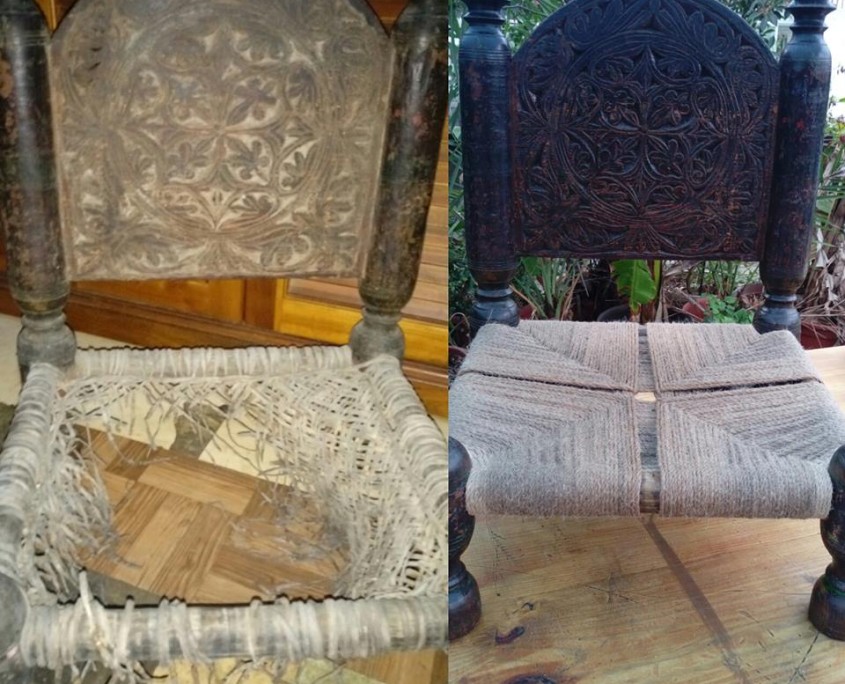
The chair– before and after Jeff worked on it. Photo by Jeff.
Yet, this dedication is not what makes him distinctive. Underlying his dedication and ingenuity, is a commitment to the environment stemming from his grandfather’s farmer ethos. He’s carried this philosophy of re-using, and re-forming materials his entire life, and it has allowed him to see materials others have disposed of not for what they are, but what they could be. Added to this, Jeff only uses natural stains and polishes, ensuring that his finished pieces are chemical free. Like always, his reasons for mixing these natural stains is part curiosity and part effort to change our world from a disposable one to a sustainable one.
To learn more about Jeff, his work, and his future plans with the Red Room, read the full interview below.
If you have a piece that needs attention, or would like to see more of Jeff’s work, he can be reached via his Facebook page.
When did you start making furniture other pieces?
My grandfather, who raised me, was a farmer. He always built what he needed, as most farmers do. Nothing is thrown away; It’s repaired until it can’t be any more, and then it’s repurposed. Because we were in a very rural area of Nova Scotia, I learned very young to build things to play with. Imagination out of necessity taught me creativity. From there I was moved to live on a hippie commune. Again, I had to create what I wanted to have. It grew from there.
Why and how did you start? What is it you find interesting about it?
I had a career in audio production for 20 some years. For the last 10 I’ve been living in Taiwan and married and I have always been fixing things in our home. When I stopped working in Isaac [with audio production], I started to make more things. I made something for my wife all of her friends loved it, they all wanted me to make [the same thing]. I started a business never really thinking it would take off, however within two or three months it quickly became the majority of my income. Now, at the end of the first year, it is my home job. What I love about it is that it’s never the same, I get the joy of creation just like I did [with audio production], except no one can download my furniture and then tell me they are not stealing from me, they are stealing from the record company. [That] kind of ruined music for me and I needed to find a source for the joy of creation somewhere else. This fit the bill.
How would you describe your work? Do you consider yourself an artist, a craftsman?
I don’t, and I honestly try to avoid that as much as possible. I’m not a wordsmith and I generally find any self inflicted description of one’s work easily falls into painful pretensions, so I let others do that. When I’m forced to I use humour and double entendre to deflect. Artist or craftsman? Neither, I’m a mechanic. I fix things that need to be repaired or I help to bring things that already exist in the material into the light of day.
I noticed much of your work comes from salvaged, repurposed or recycled material. How important is sustainability and the environment in your work?
Incredibly, part of that ethos obviously comes from my grandfather’s farmer ethic of no wasted materials, and part of it comes from my resentment of living in a disposable world. My use of natural stains and finishes is two fold: one my grandfather always wanted to but he did not have access to the internet to research how it was done a thousand years ago, and two I’ve never understood why people wanted to fill their homes with things that slowly leech carcinogens into the air. It’s part of my personal attempt to do less harm and leave a smaller footprint. We use petrochemical based things not because they are better but because they are easy to mass produce and generate huge profits for big industry. We can do better, we did for a long time before petrochemicals exploded in the 19th century , we can do better again.
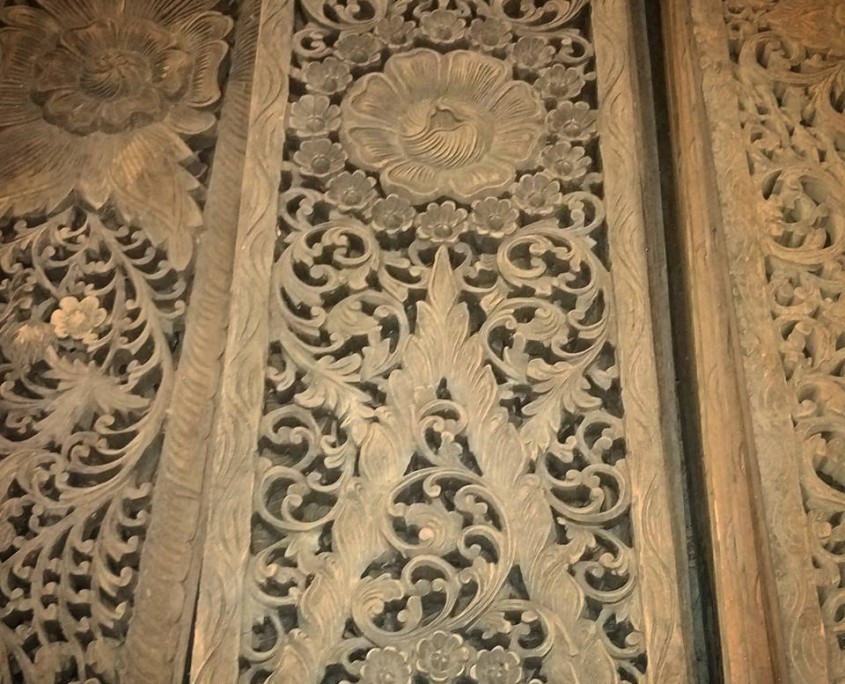
A piece he salvaged from the side of the road. Photo by Jeff.
I’ve also heard that you do not use chemicals when treating wood. Why is that? What do you use instead and what are the advantages?
Petrochemicals are used in modern woodworking because they are quick and cheap. Humans have created beautiful objects from wood millennia before petrochemicals, I choose to use things that don’t leach carcinogens into our homes because I am not an idiot. We all have the choice.
You said that part of your decision to think about sustainability comes from “your resentment of living in a disposable world”. Could you expand on that? Do you see the world changing at all?You end with saying that “we can do better again”– how do you see that happening?
I don’t know if resentment is the right word, more along the lines of embarrassment or shame. The whole instant gratification of “I want it now” and the dopamine rush of social media likes. We live in this constant cycle of fear and consumption. Media constantly grinds out stories that feed our baser fears , and drives us to buy things we don’t need. We get the warm feeling of accomplishment and security from buying extra whitening teeth strips because a commercial told us we are social failures if our teeth don’t shine like a thousand suns. That kind of baseless gratification and laziness should be an embarrassment to any thinking person. Do I see the world changing? That’s not for me to say. Can I change my world, my impact, my circle of influence? Yes I can .
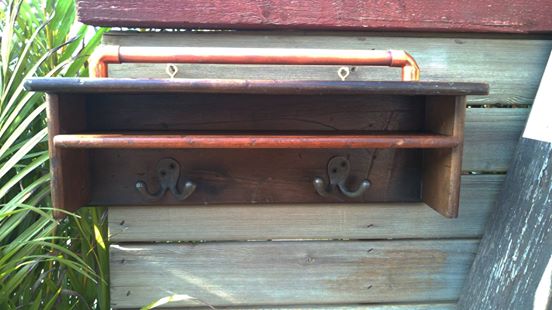
Copper and pine salvaged from a factory demolition. Photo by Jeff.
What sort of pieces do you most love working on?
The pieces that are most exciting to me are antique restoration and pieces that combine and re-purpose: antiques because I get to extend the life of something, re-purposing because it provides that pure design and invention rush. For instance, recently I made a entryway coat and key hook unit from cast iron singer, sewing tables, and walnut slabs I rescued from a lumber mill scrap pile. The coat hooks were made from railway spikes. That kind of pure rescue reuse and creation is absolute pleasure.
How did you get involved with the Red Room? Why?
I got involved with Red Room because the lovely Roma contacted me and asked if I could do some restoration work. I knew nothing of Red Room at that point but was intrigued.
Could you tell me a bit more about the Khatiyas you restored for the Red Room? What is your restoration process like?
The restoration of the Khatiyas was a series of challenges and a lot of research. When I first got them they were in really bad shape and I needed to stabilize them, to stop further deterioration. They had a profound termite infestation, and were wet, and the wood and sinew were rotting. I needed to identify the wood and then work backwards. The termite and water damage problems were solved with sunshine– weeks and weeks of constant rotation in the sun, making sure all surfaces were exposed to long, direct sun. That actually took almost a month of daily rotations and quick covers during the afternoon rains. Once I had them stabilized I had to remove the damaged material and start building them back up. I used a lot of hardwood pieces hand cut to fit in weakened or broken joints and unfortunately on one I had to resort to adding some epoxy because the structure had been so badly damaged. The last step was to apply a coconut oil and beeswax finish to seal them against further moisture and insect damage.
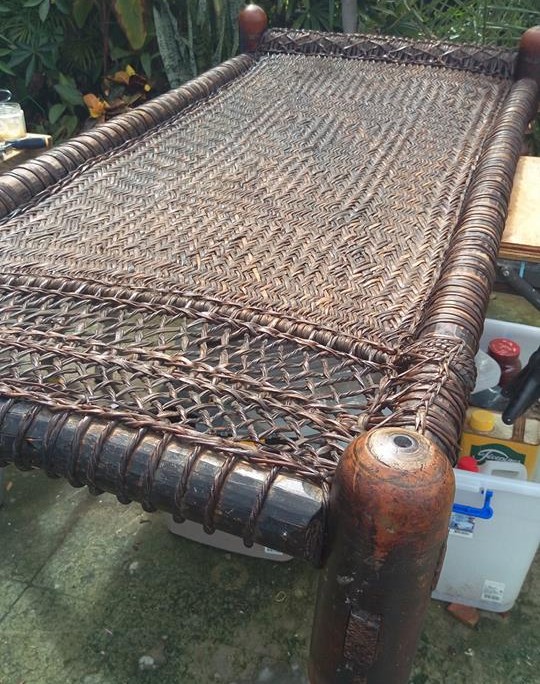
One of the Khatiyas. Photo by Jeff.
You said the Khatiyas needed a lot of research. What kind of research did you do? Was it mostly practical?
The research I had to do for the Khatiyas was 90% practical and the rest was curiosity. I needed to find as much info as I could regarding woods commonly used and construction methods, as well as an overall history of the objects. They are utilitarian but they are also so incredibly infused with beauty, one of those rare things that perfectly balances form and function. I just wanted to learn as much as I could about them before I laid out my plans to save them.
Have you since gone to any Red Room events?
I have not gone to many other Red Room events I’ve been to a few, they were lovely. I, however am not a very social person. I spent 20 years touring, playing, socializing and schmoozing as a professional musician. I’m social’ed out. I’d much rather spent quiet time with my wife my wood and my dogs. I lead a very quiet life; I work, I train, I spar, I love; repeat.
Much of what you’ve said in your interview, to me at least, seems like something Red Roomers would be interested in. Do you think you’d ever be willing to hold a workshop at the Red Room?
Roma and I have been talking about doing a workshop at Red Room, it is something that we will probably do in 2017, but right now I’m just trying to build up the business. I’m not at the point where I can refuse work while I establish the name. That keeps me booked up about 4 weeks in advance. A wonderful thing but not very flexible.
What is it about designing and inventing that interests you? Did you find your ability to create new pieces relied on practice? That is, has it become easier since you’ve started? Are there any similarities between your work in sound engineering and you work repurposing and designing new pieces?
It’s pure creation, that place where you can get lost for days. That ability, of course, becomes easier as I master new techniques. Like any other muscle the more you work it, the stronger it becomes. It adds more possibilities to my quiver and more freedom in the work. Sound engineering requires creative problem solving as much as carpentry and re-purposing do. They all rely heavily on your ability to see what something can be, not what it is.
Leah List
Photos courtesy of Jeff and JJ Chen.

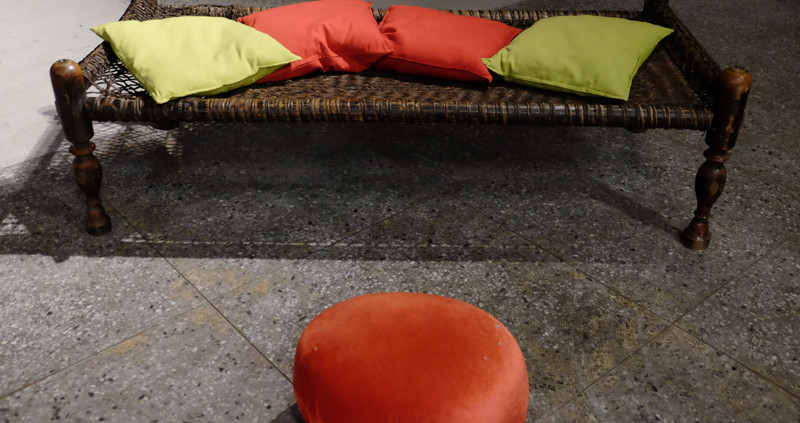
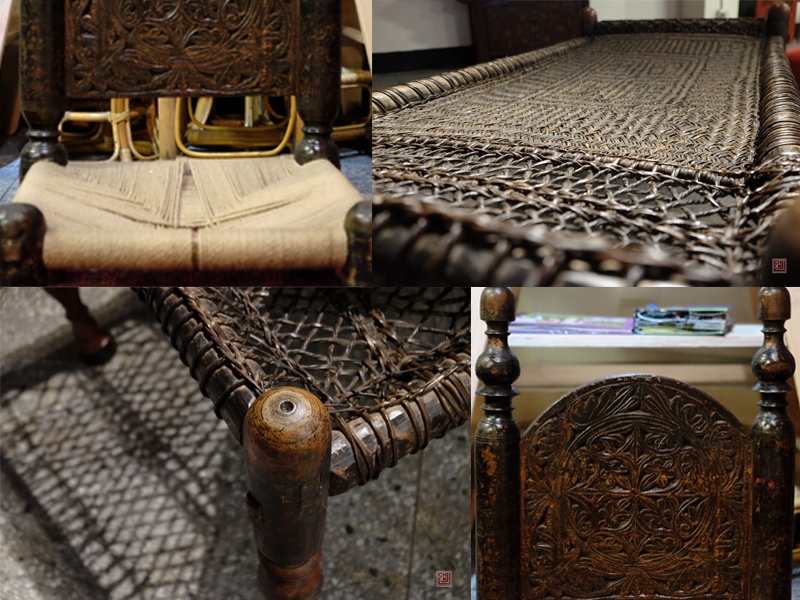

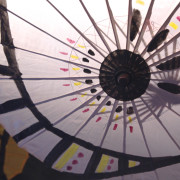
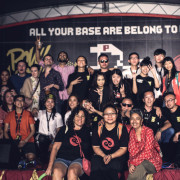




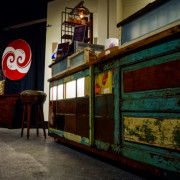


Leave a Reply
Want to join the discussion?Feel free to contribute!